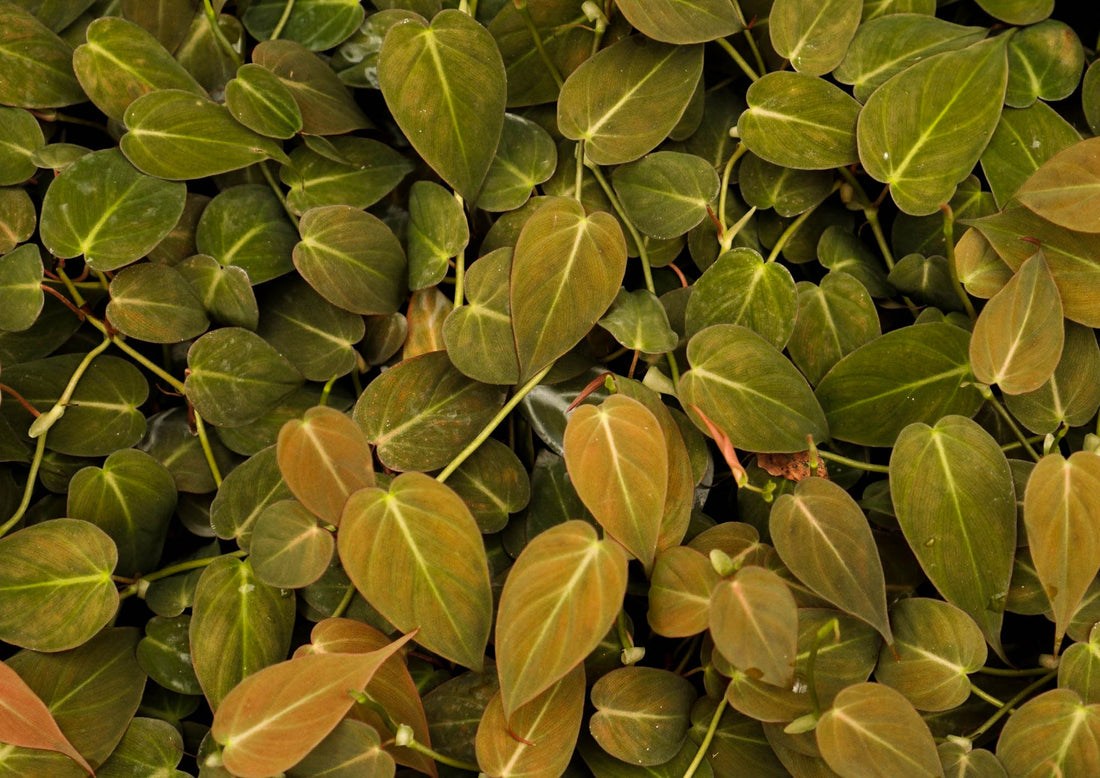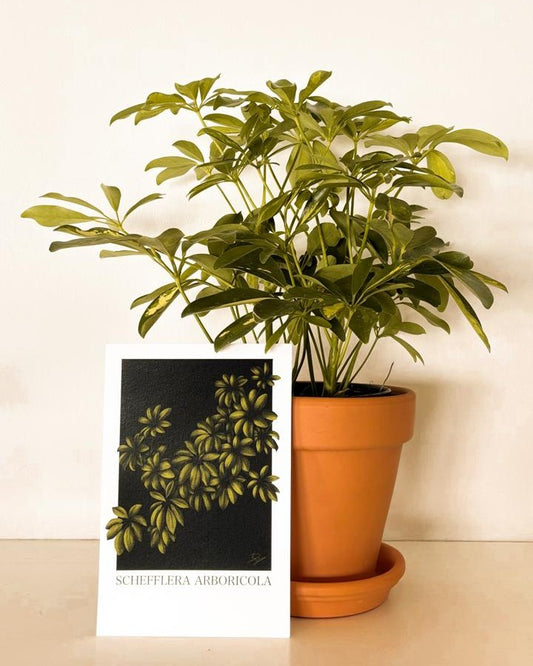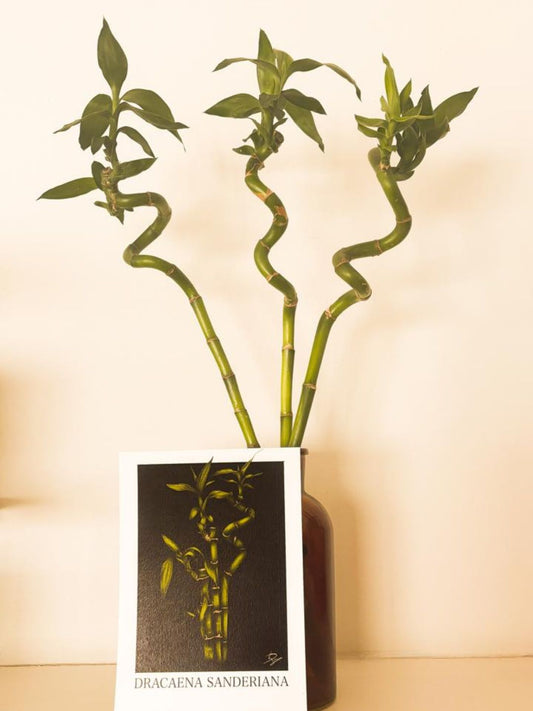
Listen, I love most plants. But when I tell you I am absolutely besotted with my Philodendron Micans, I am not exaggerating in the least. I just can’t stop staring at it and touching its soft velvet leaves. So, in order to indulge my addiction and feed my fascination, I decided to write a blog post on all things Philodendron Micans. We’re going to delve into why this vining beauty is so popular in the houseplant community, and in return, hopefully, get you as obsessed, if not more, than I am.
Origin and Interesting Facts On The Philodendron Micans

The Philodendron Micans originates from the lush rainforests of Central and South America. These plants are closely related to the heartleaf Philodendron but are definitely considered the overachievers of the family, with their easy-to-care-for yet unique beauty characteristics.
The name "micans" is Latin and means "glowing," which is fitting for how its velvety texture moves and glows in the light. Its copper undertone shining through from the back makes it look almost iridescent and also emphasizes its given name.
Philodendron Micans Care

Good news for all of you plant serial killers out there: The dark green leaves are a sign that they can tolerate and even thrive in darker spots in the home, which places them in the category of low-maintenance houseplants. As long as you follow the tips below to ensure that their basic needs are met, they shouldn’t give you any trouble, all while brightening up a sad, dark little corner of your house.
Light
As with most philodendrons, the Philodendron Micans likes bright, indirect light. The dark emerald green shade of the leaves is a sign that the plant has a high chlorophyll count, which is the compound needed in plants to absorb sufficient light for photosynthesis. This means that the Philodendron Micans can tolerate darker areas much better than plants with lighter green leaves.
Remember to never place any philodendron in direct sunlight, as this will likely cause their leaves to burn, however hardy they might appear.
Soil
Philodendron Micans prefer a well-draining, nutrient-rich soil to thrive. A perfect soil mix for them would consist of one part potting mixture, one part orchid bark, one part perlite, and one part coco coir. This combination provides the ideal balance of aeration, drainage, and moisture retention needed for healthy root development and overall plant growth.
Water
Ensure that the top 3 inches of the soil are dry before watering. This will happen quite frequently during warmer months and much less during colder months. I like to wait until my Philodendron Micans shows signs of needing water: the leaves start to slightly curl inward. Remember that these plants don’t like to be waterlogged at all, so ensure your pot has proper drainage holes at the bottom, and make sure that the water runs through completely before placing it back in its decorative container.
Temperature and Humidity
The Philodendron Micans prefers regular room temperature levels. Just be sure to keep them away from cold drafts, as they strongly dislike colder temperatures. Regarding humidity: average room humidity will suffice, but being rainforest plants, they will likely appreciate some extra humidity with the help of a humidifier.
Fertilizer
Only fertilize the Philodendron Micans during the spring and summer months, using a good quality liquid fertilizer. Depending on the exact brand of liquid fertilizer, this should vary from every 2 to 6 weeks. Refrain entirely from fertilizing during the fall and winter months, as this plant needs its beauty sleep.
Pruning
Regular pruning will help maintain the fullness of your Philodendron Micans, as they tend to get quite leggy the longer the vines grow, especially when left to trail without anything to climb on.
Common Pests
The Philodendron Micans is prone to any and all plant pests. Ensure to regularly check the top and bottom of the leaves, as well as the soil for signs of pests, especially during winter.
Propagating the Philodendron Micans
If your Philodendron Micans is getting a bit out of hand and it’s time to prune, make sure to keep the cuttings in order to propagate them and create many more Micans plants that you could either keep for yourself to feed your addiction or gift to friends!
- Ensure that the plant you took the cutting from is healthy and pest-free. It’s best to propagate during the spring and summer, but I have previously propagated plants during winter without any issues.
- Make the cut where you want on the stem between two nodes. The more nodes and leaves on the cutting, the better chance it has of rooting. Remove the bottom two leaves of the cutting.
- If possible, dip the end of your cutting in rooting hormone, and place it in a water-filled glass container, ensuring that at least one node is below the water and that no leaves are submerged.
- Wait a few weeks for roots to start emerging from the node. Once the roots are 1 or 2 inches long, or a singular root has split into two roots, then it’s time to pot up your new plant.
- Prepare the soil for the new plant by pre-watering it before removing your cutting from the water and planting it, ensuring that all of the roots are covered.
- Keep the soil consistently moist during the next two weeks, as the roots are used to being constantly hydrated (but still, the soil should never be soaking wet, as this will cause root rot). After the initial two weeks, slowly start to reduce the watering until the Philodendron Micans is on a normal watering schedule.
Common Problems With Philodendron Micans
Although the Philodendron Micans is relatively easy to care for, extreme neglect or environmental factors can significantly impact its appearance.
Brown Leaf Tips or Edges
If your Philodendron Micans leaves appear to be turning brown in spots, it may indicate low humidity. While these plants generally tolerate average home humidity, brown leaves can indicate that your environment is excessively dry. You can remedy this by placing a humidifier near your Philodendron Micans or, at the very least, placing a bowl of water nearby surrounded by other plants.
Curled Leaves
If the leaves are only slightly curled, it’s likely your plant telling you it's thirsty. However, if the leaves are tightly rolled, it indicates severe dehydration, and you need to water more frequently.
Yellowing Leaves
Several factors can cause Philodendron Micans leaves to turn yellow, but overwatering is a common culprit. Remove yellow leaves as they will not recover and only drain unnecessary energy from the plant. Place your plant in a warm spot (not in direct sunlight) to ensure the soil dries quickly. Only water your plant when at least the top 2/3 inches of the soil is dry.
Philodendron Micans Styling Tips

- Since the Philodendron Micans is a trailing plant, it’s natural to want to style it in a hanging basket, which I am all for! I think they look great trailing down, even if this means that the more it grows, the smaller its leaves will become. I still enjoy the look of it.
- Philodendrons LOVE having something to grow onto. It’s even in the name: "Philo" is Greek for “love” and "dendron" means “tree”. So it just makes sense to give them an organic-looking piece of wood to latch onto. It will give your space a very rustic, biophilic feel, which humans are naturally drawn to.
- If you keep your Philodendron Micans pruned, it will look great displayed on a coffee table, especially if the coffee table is a contrasting color to the dark green leaves, like white, birch, or even pink!
- Because of the beautiful texture of the Philodendron Micans, I like to keep the decorative container as minimalistic as possible to allow the leaves to be the star of the show.
Frequently Asked Questions
Are Philodendron Micans hard to care for?
Philodendron Micans are considered low-maintenance houseplants, requiring only a moderate amount of maintenance to thrive. They are great for beginner and experienced plant enthusiasts.
Is Philodendron Micans rare?
Philodendron Micans is not considered a rare plant. While they might not be as readily available as some popular houseplants, you should be able to find them in most nurseries at a price that won't break the bank.
Do Philodendron Micans like to climb or hang?
Philodendron Micans are avid climbers. Although they look great in a hanging basket, they definitely prefer something to hold onto while growing. You will notice that when you give them something to climb, they will grow faster, and the leaves will be much larger than when left hanging on their own accord.
How much light does a Philodendron Micans need?
The dark green shade of the leaves indicates that the Philodendron Micans has a high chlorophyll count, which is the compound needed in plants to absorb sufficient light for photosynthesis. This means that Philodendron Micans can tolerate darker areas much better than plants with lighter green leaves. However, it will thrive more in a brighter area. Always avoid direct sunlight, as this will cause the leaves to burn.





